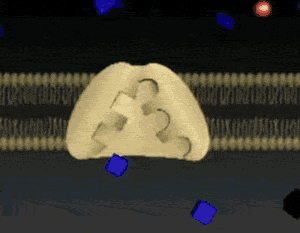

#Cell membrane na k 3d free
The energy used for Na +,K +-ATPase ion transport is transformed to provide free transport for all other sodium-dependent transport routes, including the sodium/glucose and sodium/amino acid co-transporters, the sodium/hydrogen and sodium/calcium exchangers, and the epithelial sodium channel. The kidney has, next to the brain, the highest oxygen consumption per gram of tissue, 2 and most is used for active, Na +,K +-ATPase–driven sodium reabsorption along tubules. 1 Because the kidney is the main organ responsible for control of sodium homeostasis, it comes as no surprise that Na +,K +-ATPase is abundantly expressed in renal tubular cells. The ion gradients formed by the turnover of Na +,K +-ATPase are essential for the function and viability of all mammalian cells. This creates the chemical gradient across the cell membrane that allows sodium to diffuse into the cell and an electric gradient that determines the resting membrane potential. Na +,K +-adenosine triphosphatase (ATPase) is expressed in the plasma membrane of all mammalian cells, where it pumps three Na + ions out and two K + ions into the cell for each hydrolyzed molecule of ATP. A deeper understanding of the tissue-protective role of Na +,K +-ATPase signaling and the regulation of Na +,K +-ATPase pumping activity is of fundamental importance for the understanding and treatment of kidney diseases and kidney-related hypertension. Ouabain-stimulated Na +,K +-ATPase signaling has recently shown clinical promise by protecting the malnourished embryonic kidney from adverse developmental programming. By promoting growth and inhibiting apoptosis, activation of Na +,K +-ATPase exerts tissue-protective effects. The signaling function of Na +,K +-ATPase is activated by ouabain, a mammalian steroid hormone, at far lower concentrations than those that inhibit pump activity. In the past decade, studies have revealed a novel and surprising role: that Na +,K +-ATPase is a transducer of signals from extracellular to intracellular compartments. Pump activity is downregulated by natriuretic hormones, such as dopamine, and is upregulated by antinatriuretic hormones, such as angiotensin. By producing a steep concentration difference of sodium and potassium between the intracellular and extracellular milieu, Na +,K +-ATPase in the tubules provides the driving force for renal sodium reabsorption. Across animal species and cell types, Na +,K +-adenosine triphosphatase (ATPase) is arguably the most powerful contributor to this phenomenon. The results reveal a pivotal role of NKA integrity for lymphocyte survival.The ability of cells to maintain sharp ion gradients across their membranes is the foundation for the molecular transport and electrical excitability. Ouabain protected the cells from the toxic effect of palytoxin. Intracellular Na increased and K decreased as measured by atomic absorption spectrometry in presence of palytoxin cell swelling was seen by electron microscopy. By contrast, the hydrophilic toxin palytoxin, the most potent animal poison described so far, killed all cells within 2 h at 10 nM this toxin is known to act via the sodium pump and to provoke deadly cation-leaks by unmasking a channel component. Despite pump inhibition ouabain did not alter lymphocyte survival, even at 10 mM for 30 h. Externally added ouabain, a hydrophilic cardioactive steroid, blocked the potassium uptake at nanomolar concentrations. Various incubation conditions were compared in RPMI-1640 medium cell viability was preserved for 30 h at 37 degrees C. Isolated human lymphocytes were incubated in vitro and their viability assessed by exclusion of trypan blue. We investigated whether the activity of the membrane-embedded Na,K-ATPase (EC3.6.1.37) or sodium pump (NKA) plays a role for cell survival since this ubiquitous system establishes the vital transmembrane Na and K gradients as well as the resulting high intracellular K/Na ratio required for macromolecule synthesis furthermore, the system exposes an extracellular inhibitory receptors for cardioactive steroids and palytoxin.

Besides genetic programming, extracellular factors interacting with cell surface receptors might alter cell survival. Lymphocytes are primordial immune cells with variable life times.


 0 kommentar(er)
0 kommentar(er)
